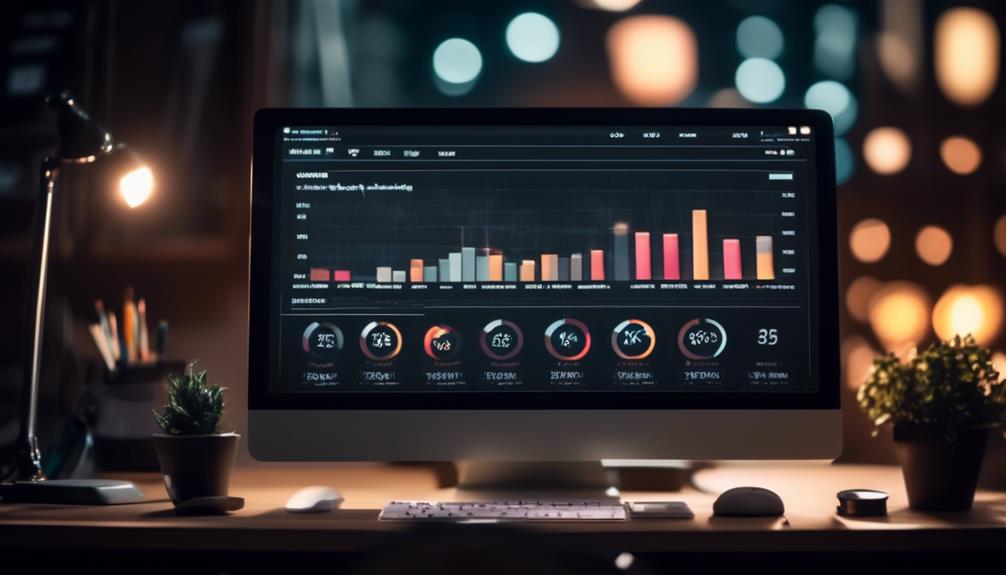As you navigate the realm of email marketing, you might find yourself facing the challenge of creating compelling content that resonates with your audience. The art of crafting emails that drive engagement and conversions requires a strategic approach that goes beyond just hitting send. By following seven effective steps in content creation, you can elevate your email marketing game and establish a stronger connection with your subscribers. From understanding your audience to implementing personalized strategies and impactful calls to action, each step plays a crucial role in maximizing the effectiveness of your email campaigns.
Role of a Virtual Assistant
When considering the effectiveness of your email marketing strategy, leveraging the role of a virtual assistant can significantly enhance productivity and streamline processes. Virtual assistant benefits are vast, from saving time by handling repetitive tasks to improving campaign efficiency through their specialized skills. These professionals can manage your email marketing calendar, ensuring timely content delivery and engagement tracking. Virtual assistant roles extend to content creation, where they can brainstorm ideas, draft compelling copy, and even design visually appealing templates for your emails.
Understanding the Audience
To excel in email marketing, you must master Audience Analysis Techniques to grasp your subscribers’ preferences. Implement Personalization Strategies to tailor content that resonates with each recipient individually. Lastly, Segmenting Email Lists is crucial for sending targeted messages and boosting engagement rates.
Audience Analysis Techniques
Understanding your audience is paramount in crafting effective email marketing campaigns. To ensure your content resonates with your subscribers, you need to utilize audience analysis techniques like demographic analysis and behavioral targeting. Here are some strategies to help you better understand your audience:
- Conduct Demographic Analysis: Utilize data on age, gender, location, and income to tailor your content.
- Implement Behavioral Targeting: Analyze your subscribers’ past interactions to personalize future emails.
- Survey Your Audience: Gather direct feedback through surveys to understand preferences and pain points.
- Monitor Engagement Metrics: Track open rates, click-through rates, and conversions to refine your email strategies.
Personalization Strategies
Craft personalized email content that resonates with your audience by implementing tailored strategies based on their preferences and behaviors. Personalization tactics and email customization are key to engaging your subscribers effectively. Start by segmenting your email list according to demographic information, purchase history, or engagement levels. Use dynamic content to address individuals by their names and recommend products based on their past interactions. Leverage automation to send targeted emails at optimal times, increasing open rates and conversions. Analyze data regularly to fine-tune your personalization strategies and ensure they align with your audience’s evolving preferences. By customizing your emails to cater to the specific needs and interests of your subscribers, you can significantly enhance the success of your email marketing campaigns.
Segmenting Email Lists
When segmenting your email lists, delve into the depths of audience insights to unlock powerful targeting capabilities for your email marketing campaigns. By understanding your audience better, you can tailor your content to their specific needs and preferences. Here are some effective strategies to segment your email lists:
- Geographic Targeting: Send location-specific content to engage customers based on their geographical location.
- Behavior-Based Segmentation: Group subscribers based on their interactions with your emails to send targeted campaigns.
- Demographic Filtering: Segment your lists by age, gender, or other demographics to personalize your emails further.
- Interest-Based Categorization: Tailor content based on subscribers’ interests and preferences to increase engagement and conversions.
Segmenting your email lists strategically can significantly improve the effectiveness of your email marketing efforts.
Crafting Engaging Content
To captivate your audience and drive action, your content must resonate deeply with their needs and desires. When crafting engaging content for email marketing, focus on content optimization and strategic engagement tactics. Begin by understanding your audience’s preferences, pain points, and aspirations. Tailor your content to address these aspects directly, showing that you comprehend their challenges and can offer solutions. Use personalized language that speaks directly to the reader, making them feel seen and understood.
Incorporate storytelling into your emails to create a connection with your audience. Share relatable anecdotes or case studies that demonstrate how your product or service can positively impact their lives. Use engaging subject lines and preview text to entice recipients to open the email. Within the email, maintain a clear and concise message that is easy to digest.
Implement interactive elements such as polls, surveys, or clickable buttons to encourage engagement. Include a strong call-to-action that prompts readers to take the next step, whether it’s making a purchase, signing up for a webinar, or downloading a resource. By prioritizing content that resonates with your audience and encourages interaction, you can enhance the effectiveness of your email marketing campaigns.
Personalization Strategies
You’re ready to enhance your email marketing game through personalized strategies that speak directly to your audience. By segmenting your target customers effectively, inserting dynamic content, and utilizing customized email templates, you can create impactful campaigns that resonate with each recipient. These personalized approaches will help boost engagement, click-through rates, and ultimately drive conversions for your business.
Targeted Audience Segmentation
How can you effectively tailor your email marketing messages to resonate with different segments of your audience and boost engagement rates? To achieve this, consider implementing the following strategies:
- Behavioral Targeting: Analyze how your audience interacts with your emails to personalize content based on their actions.
- Demographic Profiling: Segment your audience based on age, gender, income, and other relevant demographic factors for targeted messaging.
- Psychographic Segmentation: Understand the personality traits, values, and interests of your audience to create more personalized campaigns.
- Geographic Targeting: Tailor your content based on the location of your audience to make it more relevant and engaging.
Dynamic Content Insertion
Implementing dynamic content insertion in your email marketing strategy allows for personalized and engaging messages tailored to each recipient’s preferences and behaviors. By utilizing email automation tools, you can dynamically adjust the content of your emails based on factors such as past purchases, browsing history, or interaction with previous emails. This level of personalization enhances the customer experience, leading to higher engagement rates and ultimately, increased conversions. Through content optimization techniques, you can ensure that the dynamically inserted content aligns with the recipient’s interests, driving relevance and value. By incorporating dynamic content insertion into your email marketing strategy, you can deliver targeted messages that resonate with your audience, fostering stronger relationships and driving business growth.
Customized Email Templates
To further enhance the personalized touch in your email marketing strategy beyond dynamic content insertion, consider implementing customized email templates as part of your personalization strategies. Customized templates allow you to tailor your emails to individual recipients, increasing engagement and conversion rates. Here are some strategies to optimize your customized email templates:
- Design tips: Use eye-catching visuals, brand colors, and responsive layouts.
- Copywriting techniques: Craft compelling subject lines and personalized content that resonates with your audience.
- Personalization tokens: Incorporate dynamic fields like first name, location, or recent purchases.
- A/B testing: Experiment with different template designs to see what resonates best with your audience.
A/B Testing
When testing different versions of your email content to optimize performance, A/B Testing allows you to make data-driven decisions for better engagement and conversion rates. This method involves creating two variants of your email – each with a single differing element, like the subject line or email design. By sending these variants to a small portion of your subscriber list and analyzing which performs better, you gain valuable insights into what resonates with your audience.
For the subject line, A/B Testing can reveal whether a direct or a more creative approach attracts more opens. Similarly, testing different email designs can help determine whether a minimalist layout or a colorful template leads to higher click-through rates. The beauty of A/B Testing lies in its ability to uncover what truly captures your audience’s attention, allowing you to refine your email content for maximum impact. Remember, the key to effective A/B Testing is to test one element at a time to accurately assess its impact on your email marketing performance.
Editing and Proofreading
Discovering errors in your email content through thorough editing and proofreading is crucial for maintaining professionalism and ensuring your message is conveyed effectively. When it comes to reviewing your email marketing content, paying attention to details is key. Here are some essential steps to enhance the quality of your emails:
- Grammar Check: Make sure that your sentences are structured correctly and that your writing follows proper grammar rules.
- Spell Check: Eliminate any typos or spelling mistakes that could undermine the credibility of your message.
- Consistency Review: Check for consistent tone, style, and formatting throughout your email to provide a cohesive reading experience.
- Clarity Evaluation: Ensure your content is clear and easy to understand, avoiding jargon or complex language that might confuse your audience.
Call to Action Strategies
Engage your audience effectively with compelling Call to Action Strategies that drive action and achieve your marketing goals. When crafting your call to action (CTA), focus on conversion optimization to prompt immediate responses from your email recipients. Start by using clear and concise language that directs the reader on what action to take. Utilize design elements such as contrasting colors, bold fonts, or strategically placed buttons to make your CTA visually stand out in the email. Remember, the placement of your CTA is crucial; ensure it is prominently displayed and easily accessible within the email body.
To further enhance your CTA strategy, consider incorporating urgency or scarcity elements to urge quick responses from your audience. Phrases like “Limited Time Offer” or “Act Now” can create a sense of immediacy, driving higher click-through rates. Additionally, personalize your CTAs based on the recipient’s behavior or preferences to increase relevance and engagement. By implementing these effective call to action strategies, you can boost your email marketing performance and drive desired actions from your subscribers.
Frequently Asked Questions
How Can a Virtual Assistant Help With Content Creation for Email Marketing?
When it comes to content creation for email marketing, a virtual assistant can be a game-changer. They offer collaboration benefits and outsourcing advantages, freeing up time for creative brainstorming. Your business can thrive with their support.
What Are Some Advanced Strategies for Understanding the Audience Beyond Basic Demographics?
To truly understand your audience beyond basic demographics, delve into behavior analysis and psychographic insights. By studying user experience and mapping the customer journey, you can tailor email content that resonates on a deeper level.
Are There Any Unique Techniques for Crafting Engaging Content Specifically for Email Marketing?
Crafting engaging content for email marketing involves mastering interactive storytelling and visual storytelling. These techniques captivate your audience, fostering a deeper connection. Transforming mundane messages into compelling narratives boosts email engagement and ultimately drives conversions.
How Can Personalization Strategies Be Taken to the Next Level to Increase Email Engagement?
To take personalization strategies to the next level and boost engagement, delve deep into customer data for insights, use dynamic content based on behavior, segment accurately, employ interactive elements, and craft compelling subject lines that resonate with each subscriber personally.
What Are Some Innovative A/B Testing Methods That Can Be Used to Optimize Email Marketing Campaigns?
When optimizing email campaigns, always split test subject lines to boost open rates. A mere 47% increase in open rates can double conversion rates. Experiment with different strategies to find what resonates best with your audience.



